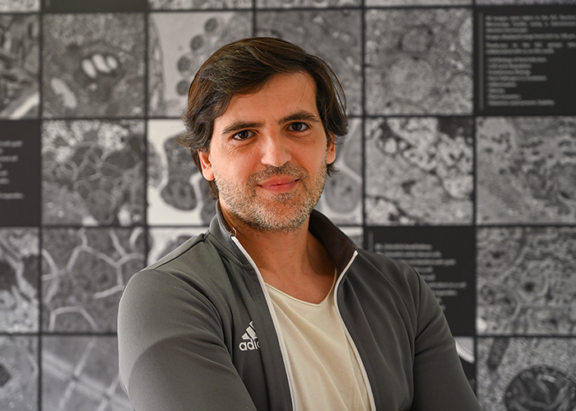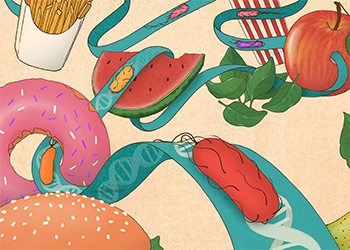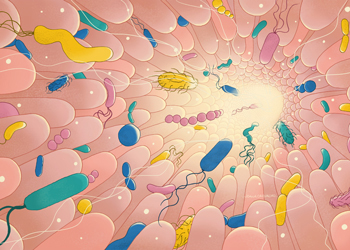
Bacterial Signalling
Karina Xavier
Bacteria use small chemical molecules called autoinducers to communicate with one another by a process called quorum sensing. This process enables a population of bacteria to regulate behaviours, which are only productive when many bacteria act in concert as a group, similarly to what happens with multi-cellular organisms.
Behaviours regulated by quorum sensing are often crucial for successful bacterial-host relationships whether symbiotic and pathogenic.
In the Bacterial signalling laboratory biochemical and genetic approaches are used to study the molecular mechanisms underlying quorum sensing, with an emphasis on systems promoting bacterial interspecies communication.
This research includes an integrated study involving elucidation of the chemical molecules that are used as signals, the network components involved in detecting the signals and processing information inside individual cells, and finally characterization of the behaviour of the bacterial community in multi-species bacterial consortia.
The research ultimate goal is to understand how bacterial signalling shapes the multi-species bacterial microbiota communities that can be found in animals and plants and how these communities affect host physiology. In particular researchers are interested in understanding how bacterial signalling plays a role in assembling, maintenance and resilience of microbiota communities.
Publications
- Dapa T., Ramiro R. S.,Pedro M. F., Gordo I. and Xavier K. B. (2022) Diet leaves a genetic signature in a keystone member of the gut microbiota. Cell Host & Microbe 30:1-17
- Vieira FJD, Nadal-Jimenez P, Teixeira L, Xavier KB (2020) Erwinia carotovora quorum sensing system regulates host-specific virulence factors and development delay in Drosophila melanogaster.. mbio 11:e01292-20
- R. A. Oliveira, K. M. Ng, M. B. Correia, V. Cabral, H. Shi, J. L. Sonnenburg, K. C. Huang, K. B. Xavier (2020) Klebsiella michiganensis transmission enhances resistance to Enterobacteriaceae gut invasion by nutrition competition. Nature Microbiology DOI: 10.1038/s41564-019-0658-4
- Barroso-Batista, J., Pedro, M. F., Sales-Dias, J. , Pinto, C. J. G., Pereira, H. , Demengeot, J., Gordo, I., Xavier, K. (2020) Specific Eco-Evolutionary Contexts in the Mouse Gut Reveal Escherichia coli Metabolic Versatility. Current Biology In press. Available at SSRN: http://dx.doi.org/10.2139/ssrn.3433809 (August 7, 2019)
- Torcato I.M., Kasal, M.R., Brito, P.H., Miller, S.T., Xavier, K.B. (2019) Identification of novel autoinducer-2 receptors in Clostridia reveals plasticity in the binding site of the LsrB receptor family.. J Biol Chem. 294(12):4450-4463
- Ng KM, Aranda-Díaz A, Tropini C, Frankel MR, Van Treuren W, O'Laughlin CT, Merrill BD, Yu FB, Pruss KM, Oliveira RA, Higginbottom SK, Neff NF, Fischbach MA, Xavier K.B., Sonnenburg J.L., Huang K.C. (2019) Recovery of the Gut Microbiota after Antibiotics Depends on Host Diet, Community Context, and Environmental Reservoirs. Cell Host Microbe 26(5):650-665.e4. doi: 10.1016/j.chom.2019.10.011.
- Özkaya, Ö., Balbontín R., Gordo I., and Xavier, K.B. (2018) Cheating on cheaters stabilizes cooperation in Pseudomonas aeruginosa. Current Biology 28(13):2070-2080
- Valente, R.S., Nadal-Jimenez, P., Carvalho A.F.P., Vieira, F.J.D., Xavier, K.B. (2017) Signal Integration in Quorum Sensing Enables Cross-Species Induction of Virulence in Pectobacterium wasabiae.. MBio 8(3):pii: e00398-17
- Thompson, J.A., Oliveira, A.R., Djukovic, A., Ubeda, C., Xavier, K.B. (2015) Manipulation of the Quorum-Sensing signal AI-2 affects the antibiotic-treated gut microbiota.. Cell Reports 10:1–11
- Barroso-Batista, J., Sousa, A., Lourenço, M., Bergman, ML, Sobral, D., Demengeot, J., Xavier, K.B., I. Gordo (2014) The first steps of adaptation of escherichia coli to the gut are dominated by soft sweeps adaptation of Escherichia coli in the mouse gut and continuous clonal interference. PLoS Genetics 10(3):e1004182
- Marques, J.C., Oh, Il K., Ly, D.C., Lamosa, P., Ventura, M.R., Miller, S.T., Xavier, K.B. (2014) LsrF, a coenzyme A-dependent thiolase, catalyzes the terminal step in processing the quorum sensing signal autoinducer-2. Proc Natl Acad Sci U S A 111:14235-40
- Pereira, C.S., Thompson, J.A., Xavier, K.B. (2013) AI-2-mediated signalling in bacteria. FEMS Microbiol Rev 37:156-181
- Pereira, C.S., Santos, A.J.M., Bejerano-Sagie, M., Correia, P.B., Marques, J.C., Xavier, K.B. (2012) Phosphoenolpyruvate Phosphotransferase System regulates detection and processing of the quorum sensing signal Autoinducer-2. Mol. Micro 84:93-104
- Pereira, C.S., de Regt, A.K., Brito, P.H, Miller, S.T., Xavier, K.B. (2009) Identification of functional LsrB-like autoinducer-2 receptors. J Bacteriol 191:6975-87
- Bejerano-Sagie, M., Xavier, K.B. (2007) The Role of Small RNAs in Quorum-Sensing. Curr Opin Microbiol 10:189-98
- Xavier, K.B., Bassler, B.L. (2005) Interference with AI-2-mediated bacterial cell-cell communication. Nature 437:750-753
- Xavier, K.B., Bassler, B.L. (2005) Regulation of uptake and processing of the quorum-sensing autoinducer AI-2 in Escherichia coli. J. Bacteriol 187:238-48



